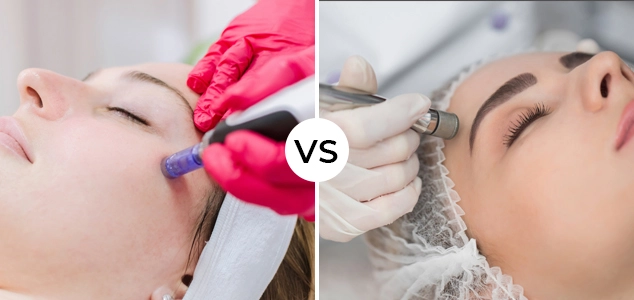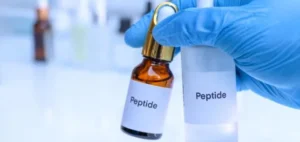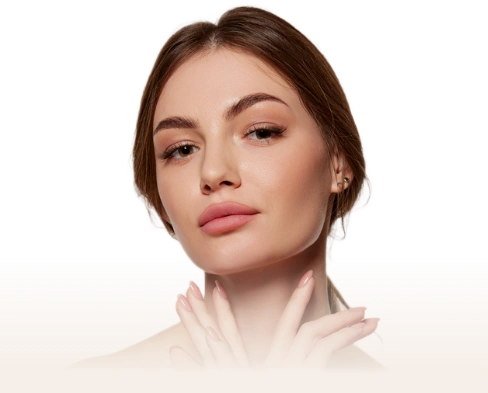Your skin might look dull and old because of dead and damaged cells, but you can fix all this with exfoliation. Microneedling and microdermabrasion are two popular ways to do this.
Microneedling uses tiny needles to stimulate your skin to repair itself by creating micro injuries, while microdermabrasion removes dead cells using a special tool.
Microneedling is good for deep wrinkles and old scars, while microdermabrasion is better for new scars and making your skin much more smooth.
Here is the brief explanation to people’s search for “Microneedling vs Microdermabrasion”.
What is Microneedling and How Does it Work?
Microneedling, also known as collagen induction therapy, is a minimally invasive cosmetic procedure that involves the use of a device containing fine needles to create controlled micro-injuries on the skin.
These micro-injuries stimulate the body’s natural wound healing process, leading to increased production of collagen and elastin, which are essential proteins for maintaining skin elasticity and firmness. Microneedling is commonly used to improve the appearance of scars, wrinkles, fine lines, and uneven skin texture, as well as to enhance overall skin rejuvenation. It can be performed on various areas of the body and typically requires multiple sessions for optimal results.
What is Microdermabrasion and How Does it Work?
Microdermabrasion, introduced in 1985 as a gentler alternative to dermabrasion and chemical peels, is a popular non-invasive cosmetic procedure aimed at resurfacing the skin’s top layer. It employs mechanical abrasion to exfoliate the skin, typically using a wand-like device that either sprays tiny aluminum oxide crystals or utilizes a rough-textured diamond tip to remove dead cells.
This exfoliation process not only promotes brighter and more even-toned skin but also stimulates collagen production, gradually improving skin texture and addressing issues like acne scars, wrinkles, large pores, and hyperpigmentation. Microdermabrasion can stand alone as a treatment or be combined with other cosmetic procedures such as laser therapy, chemical peels, or microcurrent for enhanced results.
Microneedling Procedure
Microneedling is an outpatient procedure that typically lasts between 15 minutes to a few hours, depending on the severity of skin conditions and treatment area size. Before the procedure, a numbing cream is applied for 30 to 45 minutes to minimize the discomfort.
During microneedling, a tool with tiny needles is used to create controlled micro-injuries on the skin, with needle length ranging from .5 to 2 millimeters. Longer needles are used for deeper skin conditions like acne scars. Sensations during the procedure may include warmth, scratching, and slight discomfort, particularly in bony areas, with potential for minor bleeding during deeper treatments.
Post-procedure, redness and swelling are common, and are typically resolved within a week. While it’s generally safe, there are potential risks including minor bruising, scarring, or skin infection.
Microdermabrasion Procedure
Microdermabrasion, often called a “lunch hour” treatment for its quick nature, lasting around 50 minutes, and not even requiring anesthesia or any other numbing agent. It includes a device with an abrasive surface, it gently buffs away the skin’s top layer, revealing a refreshed look. It also suctions away dead skin cells, promoting circulation for a glowing complexion.
There’s usually no downtime, though some may experience minor bruising afterwards. The process involves a skin assessment, double cleanse, microdermabrasion for face and neck, light manual extraction, application of a Hydrojelly mask, facial massage, and shoulder massage.
Microneedling Benefits
- Boosts collagen and elastin, making skin firmer
- Smooths skin texture and lessens scars, even acne scars
- Reduces wrinkles and fine lines
- Evens out skin tone and fades dark spots
- Refreshes overall skin appearance
- Can be used on different body parts
- Little downtime and generally safe
- May improve effectiveness of skincare products applied afterward
Microdermabrasion Benefits
- Removes dead skin cells to make skin look fresh
- Makes skin texture and tone better
- Helps reduce wrinkles and fine lines
- Makes pores look smaller
- Lightens dark spots and age spots
- Helps skincare products work better
- Makes makeup go on smoother
- You can get back to your routine quickly
- Works for different skin types
What Conditions Microneedling Treats?
- Acne scars
- Hyperpigmentation or uneven skin tone
- Fine lines or wrinkles
- Enlarged pores
- Stretch marks
- Loose skin
What Conditions Microdermabrasion Treats?
- Hyperpigmentation
- Issues with skin texture
- Sun damage
- Fine lines and wrinkles
- Acne or acne scarring
- Stretch marks
- Uneven skin tone
- Melasma
- Dead, dull-looking skin
Microneedling vs Microdermabrasion: What Should One Prefer?
If you want to address minor aging signs, stretch marks, sun damage, or surface-level skin conditions, microdermabrasion can be an effective treatment. However, for concerns involving deeper skin issues like stubborn acne scars, microneedling is often a more suitable option.
Microneedling penetrates deeper into the skin, naturally stimulating collagen production to promote firmer, smoother skin texture. It’s particularly effective for treating fine lines, as it targets the root cause by encouraging collagen regeneration through tiny skin injuries.
If you’re unsure which treatment is best for your specific needs, our experienced team can provide guidance tailored to your goals and preferences.
Book your appointment with Dr. Syra Hanif in New York City, and learn which treatments would suit you better.

About The Author
Dr. Syra Hanif M.D.
Board Certified Primary Care Physician
Dr. Hanif is the Director of Aesthetic Medicine. She is a board-certified physician in Aesthetic Medicine who specializes in using non-surgical alternatives in order to enhance one's appearance through Botox and fillers.
Read More











